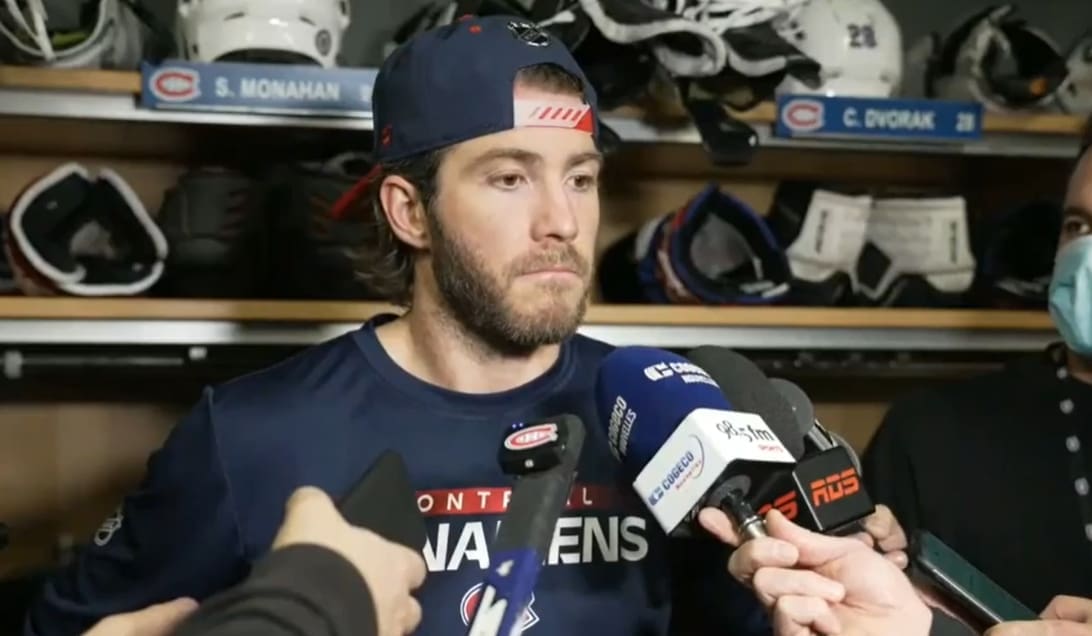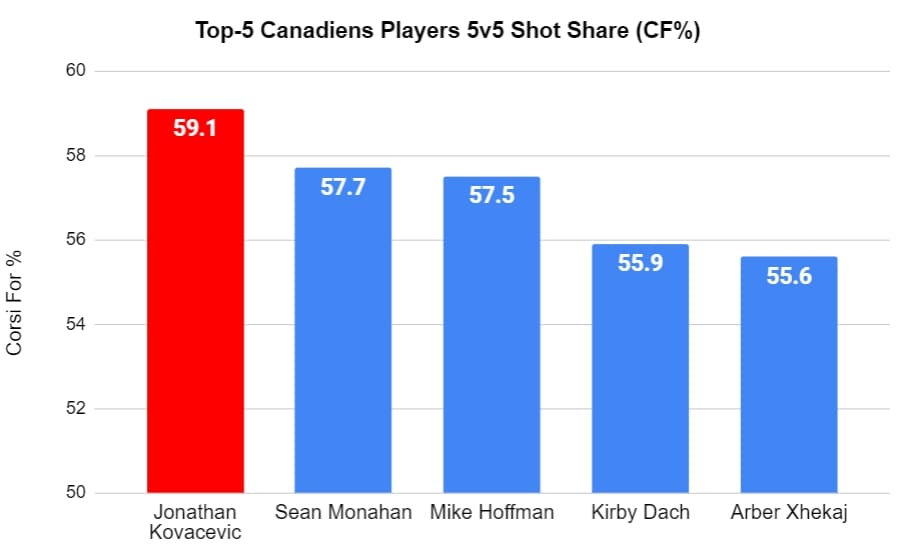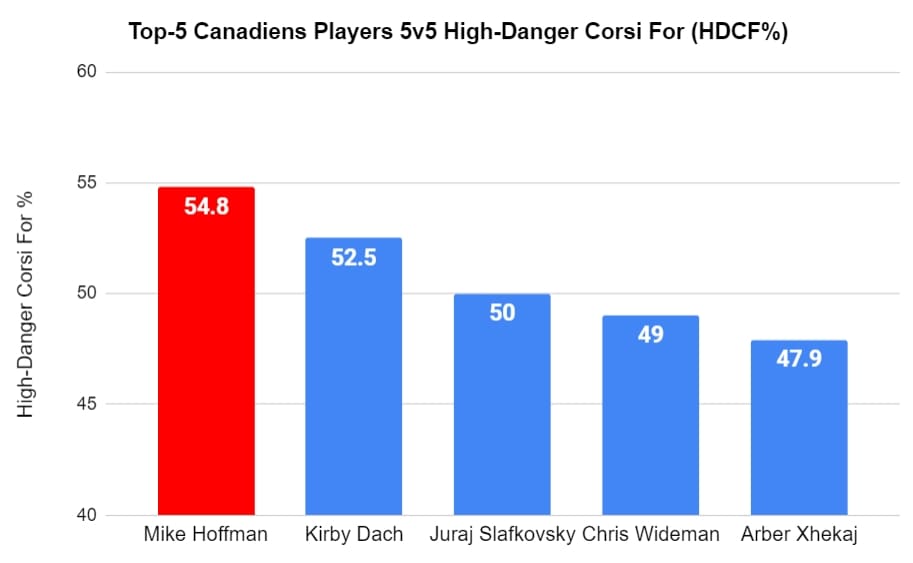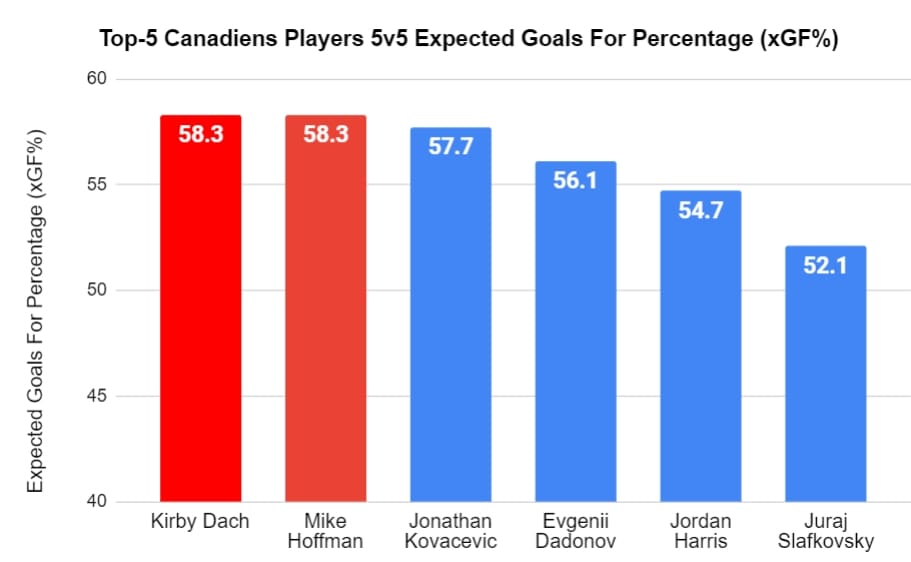Montreal Canadiens
Top-5 Canadiens Players According To The Numbers

Despite icing a roster including a bevy of inexperienced players, the Montreal Canadiens have managed to maintain a .500 record through the first eight games of the season.
It’s probably a little too early to project whether they’ll be able to maintain their current pace, but there is a decent sample size available when it comes to individual players, and the early-season results have been quite interesting, to say the least.
Shot Share (CF%)
The first number we’ll investigate is the most common underlying metric used in hockey: Corsi For Percentage (CF%).
What does it mean? CF% is used to measure the shot attempt differential when certain players are on the ice. It counts the shots that make it to the net, shots that aren’t on target, as well as blocked shot attempts.
Example: The Canadiens generated 7 shots while Brendan Gallagher was on the ice while allowing 3 shots against. Thus, Gallagher’s Corsi For Percentage is 70 percent of the total shots (7 of 10).
It’s a quick and easy way to judge which players generally make an impact when it comes to controlling shots, which, as we all know, is usually the most important aspect of a hockey game.
When it comes to the Montreal Canadiens’ best players in this category, the results are somewhat surprisng.
Newcomer Jonathan Kovacevic, who has quietly put together several fantastic performances for the Canadiens, leads all players with an impressive 59.1 CF%. His defensive partner, Jordan Harris, ranks just outside of Top-5 with 53.1 CF%.

It’s also worth noting rookie Arber Xhekaj is among the Canadiens’ best players when it comes to controlling shots.
And while you may expect players like Nick Suzuki and Cole Caufield in the lead among forwards, they’re closer to the bottom of the list when it comes to CF%. The reason? First off, they’re facing opposing teams’ best players, but they’ve also struggled to form chemistry with most of the players used on their line.
When it comes to those two, the results have been encouraging, but the process has been a mess.
But when Mike Hoffman, the third-best player on the roster when it comes to controlling shots, was added to their line against the Buffalo Sabres on Thursday, the line immediately saw a significant uptick in shot share.
That may be surprising, but the numbers don’t lie, when Hoffman is on the ice he does not hurt the Canadiens by any means. There’s been a lack of production since the start of the year, but the process has been quite good.
Newcomers Sean Monahan and Kirby Dach also feature in the top 5, owing to their ability to drive the play and maintain control of the puck when entering the offensive zone.
High-Danger Chances For (HDCF%)
CF% is a start when it comes to analyzing performances, but it doesn’t tell the whole story.
Peppering the opposing goaltender is good, but a shot from the slot has more chances to score than a floater from the point.
Thus, we must take a look at how players impact the team’s share of high-danger chances.
Hoffman leads all Montreal Canadiens players, with the team controlling almost 55 percent of the high-danger chances when he’s on the ice. Dach follows closely, which is a little less surprising, but just behind him is first-overall pick Juraj Slafkovsky.

Slafkovsky has missed three games, but his numbers before the injury were quite encouraging.
Rounding out the top 5 is the Canadiens’ third pairing of Xhekaj and Chris Wideman, who have faced a lower quality of competition than the other defensive pairings.
Expected Goals Share Percentage (xGF%)
CF% and HDCF% give us a good idea of how often a team is shooting as well as how often those shots come from high-danger areas, but what about all the other factors?
Expected goals for percentage (xGF%) is a statistic based on shots, but those shots have been weighted for shot quality, including factors such as the type of shot, the location, whether the shot was taken on the rush, or even a rebound.
It gives us a better idea of overall performance, which, in turn, reveals whether a certain player’s production is sustainable.
In the Montreal Canadiens’ case, it reveals both Dach and Hoffman have been making a positive impact on the team, despite relatively underwhelming production. It’s not guaranteed, but logically, the pair should start scoring a lot more in the future.

Harris and Kovacevic make another appearance, which can be considered surprising given the pair have 30 games of experience between the two of them. But the results align nicely with the good old-fashioned eye test. When Kovacevic and Harris are on the ice, good things happen for the Canadiens.
Evgenii Dadonov, who is yet to register a point this season, probably won’t have to wait too long. When he’s on the ice, the puck tends to find itself in the offensive zone rather than the defensive zone.
You’ll also notice Slafkovsky is on the right side of 50 percent, and while he’s not exactly in the top 5 on the team, there are only six players on the roster who have made a positive impact when it comes to xGF%, which justifies adding the rookie to the list.
TL;DR
- Despite all the criticism sent his way, Mike Hoffman is making a positive impact on the Canadiens when it comes to controlling shots and scoring chances.
- Kirby Dach has only scored one goal since the start of the season, but the numbers suggest his production should increase shortly.
- The Jonathan Kovacevic and Jordan Harris pairing isn’t just treading water. It’s fairly dominant.
- Juraj Slafkovsky’s underlying numbers are well above replacement level.
(All statistics are 5v5 unless otherwise noted, via NaturalStatTrick)








